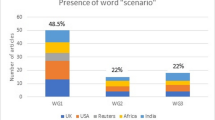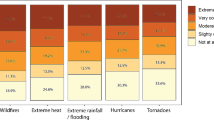Abstract
Decision-making for climate adaptation operates in an uncertain environment. Formal processes to decision-making under uncertainty weigh the ability of a decision rule to achieve multiple and sometimes conflicting objectives in an evaluation procedure. Increasingly, computer simulation models are being applied for this reason, so that the effectiveness of decisions can be evaluated before actually implementing them in reality. In this paper, we develop a simple stochastic simulation model of beach recession under climate change in Australia and evaluate decision rules for beach replenishment in the context of three management objectives: (i) to reduce beach recession, (ii) reduce variation in beach recession, and (iii) do so cost-effectively. Results indicate that a decision to intervene and replenish the beach based on a trigger level would be effective at maintaining shoreline position, with relatively little variation, but did so at a relatively high cost of multiple interventions. A decision procedure to intervene at a fixed period resulted in greater shoreline position variation but constrained management efforts and costs. This structured approach offers an evidence-based process to decision-making that lays bare the assumptions upon which decisions are made. This, in turn, allows for a more complete analysis of all the uncertainties and better outcomes.



Similar content being viewed by others
References
Adger W, Dessai S, Goulden M, Hulme M, Lorenzoni I, Nelson D, Naess L, Wolf J, Wreford A (2009) Are there social limits to adaptation to climate change? Clim Change 93:335–354
Bather J (2000) Decision theory: an introduction to dynamic programming and sequential decisions. Wiley, London
Beach D (ed) (2002) Coastal sprawl: the effects of urban design on aquatic ecosystems in the United States. Pew Oceans Commission, Arlington
Boschetti F, de la Tour A, Fulton EA, Little LR (2010) Interactive modelling for natural resource management. Env Mod Softw 25:1075–1085
Bunnefeld N, Hoshino E, Milner-Gulland EJ (2011) Management strategy evaluation: a powerful tool for conservation. Trees 26:441–447
Callaghan DP, Ranasinge R, Roelvink D (2013) Probabilistic estimation of storm erosion using analytical, semi-empirical, and process based storm erosion models. Coast Eng 82:64–75
Collins D (2009) Contesting property development in Coastal New Zealand: a case study of Ocean Beach, Hawke’s Bay. Int J Urban Reg Res 33:147–164
Cowell PJ, Thom BG, Jones RA, Everts CH, Simanovic D (2006) Management of uncertainty in predicting climate-change impacts on beaches. J Coast Res 22:232–245
Daron J (2014) Challenges in using a Robust Decision Making approach to guide climate change adaptation in South Africa. Clim Chang 1–15
Dessai S, Hulme M (2004) Does climate adaptation policy need probabilities? Clim Pol 4:107–128
Dessai S, Wilby R (2011) How can developing country decision makers incorporate uncertainty about climate risks into existing planning and policymaking processes? World Resources Report Uncertainty Series. Available at http://www.worldresourcesreport.org/
Fankhauser S, Smith JB, Tol RS (1999) Weathering climate change: some simple rules to guide adaptation decisions. Ecol Econ 30(1):67–78
Francis RICC, Shotton R (1997) “Risk” in fisheries management: a review. Can J Fish Aquat Sci 54:1699–1715
Fulton EA, Smith ADM, Smith DC, van Putten IE (2011) Human behaviour: the key source of uncertainty in fisheries management. Fish Fish 12:2–17
Groves DG, Lempert RJ (2007) A new analytic method for finding policy-relevant scenarios. Glob Environ Chang 17:73–85
Hammond JS, Keeney RL, Raiffa H (1999) Smart choices: a practical guide to making better decisions. Harvard Business School Press, Boston
Harwood J (2000) Risk assessment and decision analysis in conservation. Biol Conserv 95:219–226
Hilborn R, Mangel M (1997) The ecological detective: confronting model with data. Princeton University Press
Hillen R, de Haan T (1993) In: Hillen R, Verhagen HJ (eds) Development and implementation of the coastal defence policy for the Netherlands. Coastlines of the southern North Sea American Society of Civil Engineers, New York
Hunter J (2010) Estimating sea-level extremes under conditions of uncertain sea-level rise. Clim Change 99:331–350
IPCC (2012) Summary for policymakers. In: Field CB (ed) Managing the risks of extreme events and disasters to advance climate change adaptation. Cambridge University Press, Cambridge, pp 1–19
Jongejan RB, Ranasinghe R, Vrijling JK, Callaghan D (2011) A risk-informed approach to coastal zone management. Aust J Civ Eng 9:47–60
Jotzo F, Betz R (2009) Australia’s emissions trading scheme: opportunities and obstacles for linking. Clim Pol 9:402–414
Keeney RL, Raiffa H (1976) Decisions with multiple objectives: preferences and value tradeoffs. Wiley, New York
Lempert RJ, Collins MT (2007) Managing the risk of uncertain threshold response: comparison of robust, optimum, and precautionary approaches. Risk Anal 27:1009–1029
Mapstone BD, Little LR, Punt AE, Davies CR, Smith ADM, Pantus F, McDonald AD, Williams AJ, Jones A (2008) Management strategy evaluation for line fishing in the Great Barrier Reef: balancing conservation and multi-sector fishery objectives. Fish Res 94:315–329
Mariani A, Shand TD, Carley JT, Goodwin ID, Splinter K, Davey EK, Flocard F, Turner IL (2012) Generic design coastal erosion volumes and setbacks for Australia. Antarctic Climate & Ecosystems Cooperative Research Centre, Hobart
Milligan J, O’Riordan T, Nicholson-Cole SA, Watkinson AR (2009) Nature conservation for future sustainable shorelines: lessons from seeking to involve the public. Land Use Policy 26:203–213
Milner-Gulland EJ, Rowcliffe MJ (2007) Conservation and sustainable use: a handbook of techniques. Oxford University Press
Muenning P (2008) Decision analytic modeling. Int Encycl Pub Health 71–76
New M, Hulme M (2000) Representing uncertainty in climate change scenarios: a Monte-Carlo approach. Integr Assess 1(3):203–213
New M, Lopez A, Dessai S, Wilby R (2007) Challenges in using probabilistic climate change information for impact assessments: an example from the water sector. Phil Trans R Soc A 365:2117–2131
Nicholls RJ, Leatherman SP, Dennis KC, Volonté CR (1995) Impacts and responses to sea-level rise: qualitative and quantitative assessments. J Coast Res 14:26–43
Peterman RM, Anderson JL (1999) Decision analysis: a method for taking uncertainties into account in risk-based decision making. Hum Ecol Risk Assess Int J 5:231–244
Plaganyi EE, Skewes TD, Dowling NA, Haddon M (2013) Risk management tools for sustainable fisheries management under climate change: a sea cucumber example. Clim Change 119:181–197
Punt AE, Hilborn R (1997) Fisheries stock assessment and decision analysis: the Bayesian approach. Rev Fish Biol Fish 7:35–63
Raiffa H (1979) Decision analysis: introductory lectures on choices under uncertainty. McGraw-Hill
Ranasinghe R, Callaghan D, Stive MF (2012) Estimating coastal recession due to sea level rise: beyond the Bruun rule. Clim Change 110:561–574
Rosenberg AA, Brault S (1993) Choosing a management strategy for stock rebuilding when control is uncertain. In: Smith SJ, Hunt JJ, Rivard D (eds) Risk evaluation and biological reference points in fisheries management. Canadian Special Publication of Fisheries and Aquatic Sciences 120, National Research Council of Canada
Rosenzweig C, Solecki W, Blake R, Bowman M, Faris C, Gornitz V, Horton R, Jacob K, LeBlanc A, Leichenko R, Linkin M, Major D, O’Grady M, Patrick L, Sussman E, Yohe G, Zimmerman R (2011) Developing coastal adaptation to climate change in the New York City infrastructure-shed: process, approach, tools, and strategies. Clim Change 106:93–127
Sainsbury KJ, Punt AE, Smith ADM (2000) Design of operational management strategies for achieving fishery ecosystem objectives. ICES J Mar Sci 57:731–741
Short A (2012) Wave-dominated beaches. In: Geoscience Australia (ed) OzCoasts
Smith MD, Slott JM, McNamara D, Brad Murray A (2009) Beach nourishment as a dynamic capital accumulation problem. J Environ Econ Manag 58(1):58–71
Stainforth DA et al (2005) Uncertainty in predictions of the climate response to rising levels of greenhouse gases. Nature 433:403–406
Weaver CP, Lempert RJ, Brown C, Hall JA, Revell D, Sarewitz D (2013) Improving the contribution of climate model information to decision making: the value and demands of robust decision frameworks. Wiley Interdiscip Rev Clim Chang 4:39–60
Wise RM, Fazey I, Stafford Smith M, Park SE, Eakin HC, Archer Van Garderen ERM, Campbell B (2014) Reconceptualising adaptation to climate change as part of pathways of change and response. Glob Environ Chang 28:325–336
Acknowledgments
We thank Russell Gorddard and Art Langston from the Land and Water Flagship of the CSIRO for their comments and suggestions in earlier drafts of the paper. This research was funded by the CSIRO Climate Adaptation Flagship.
Author information
Authors and Affiliations
Corresponding author
Rights and permissions
About this article
Cite this article
Little, L.R., Lin, B.B. A decision analysis approach to climate adaptation: a structured method to consider multiple options. Mitig Adapt Strateg Glob Change 22, 15–28 (2017). https://doi.org/10.1007/s11027-015-9658-8
Received:
Accepted:
Published:
Issue Date:
DOI: https://doi.org/10.1007/s11027-015-9658-8




